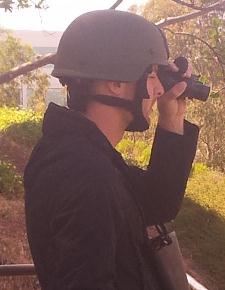
Online Exclusive: Turn Up the Heat on Bad Guys Using Thermal Imagers and Night Vision
Thermal imagers allow you to “detect” a target by amplifying the heat signature of something or someone, where night vision amplifies ambient light by millions of times so that you can “identify” a target in minimal light.
- By Spiro Demetriadi
- May 31, 2013
 It is now common knowledge that one of the Boston Marathon bombing suspects was found by a Law Enforcement helicopter using a thermal imager. The suspect's heat signature was detected while he was hiding under a tarp in a boat parked in a residential backyard. From there the pilot was able to direct the ground-based tactical teams to respond. In some areas of Law Enforcement and Security it seems that thermal technology is the next hot thing, but it has been around for decades.
It is now common knowledge that one of the Boston Marathon bombing suspects was found by a Law Enforcement helicopter using a thermal imager. The suspect's heat signature was detected while he was hiding under a tarp in a boat parked in a residential backyard. From there the pilot was able to direct the ground-based tactical teams to respond. In some areas of Law Enforcement and Security it seems that thermal technology is the next hot thing, but it has been around for decades.
To be able to see in low-light/no-light conditions, other than using white light, there are two primary types of technologies: thermal (IR) and night vision (I2). Each technology has its pros and cons and the best-case scenario is using all of these technologies as needed to increase situational awareness. Thermal imagers allow you to “detect” a target by amplifying the heat signature of something or someone, where night vision amplifies ambient light by millions of times so that you can “identify” a target in minimal light.
There are big, heavy thermal imagers that can be fixed-mounted on aircraft, trucks or building infrastructures with detection range capabilities of several miles. On the other end of the spectrum, which we will cover here, are mobile thermal imagers that have less than a mile detection range that are small, lightweight and can be hand-held or helmet mounted for ground-based tactical operations.
Here is an example of how thermal imaging can help in a hypothetical situation. You are a security contractor responsible with protecting the personnel and infrastructure of a facility that stores hazardous materials and it is an ideal target for terrorists because it is in close proximity to a well-populated residential area. It is 10:30 PM in the evening, with partly cloudy skies and a half moon. You have fences, bollards, motion sensors and other security measures to detect and prevent intrusion of the perimeter. Despite these measures, you confirm that shots have been fired and a hostile element has breached your perimeter through the main gate. You are under a terrorist attack. The terrorists are moving swiftly towards your building, which is 200 yards away, and they are using all available cover and concealment, such as parked vehicles, walls and trashcans.
The entire facility is now on lock-down, most of the lights are off and you have limited staff working. You order your sharpshooter to the roof. He has a sniper rifle with a mounted day scope, clip-on night vision sight and laser. He has little time to spare because his mission now is to prevent these terrorists from entering the building. He uses the PVS-14TM (Thermal Monocular), which quickly allows him to detect the heat signature of the threat and he is able to confirm that there are three bad guys. Now that he knows their location, he utilizes his sniper rifle with night vision to see that they are carrying rifles and are wearing backpacks that could be full of explosives. Via radio, a sharpshooter updates his four-man tactical strike team to search and engage the terrorists that have made it into the building.
Each strike team member has common SWAT gear like ballistic helmet, body armor, carbine (with flashlight/laser) and a handgun. They have mounted on their helmet, over their non-dominant eye, the NEPVS-14 (Night Enforcer) night vision monocular and are using the low-light/no-light conditions to maintain stealth. Night vision is used as they sweep the building. The team leader can use the thermal monocular so that he can quickly detect any heat signature. However, the thermal imager does not allow him to identify the person hiding behind a cart. He uses night vision again in order to verify the terrorists and the team can then take appropriate action.
The above is one of potentially many scenarios that shows how using both thermal and night vision technologies can increase the situational awareness, survivability and operational capabilities (SASOC) of those responsible for the safety and security of personnel and infrastructures. Seeing while being unseen transforms a situation so that the good guys are the hunters and the bad guys are the prey.
About the Author
Spiro Demetriadi is the Director of Sales/Marketing for Morovision, a leading provider of night vision and thermal equipment and tactical training to Federal, State, County and Local Law Enforcement and Homeland Security.
Spiro is a US Army veteran and for the past 20 years has represented the Gracie Academy (Headquarters), where he handles combatives training for thousands of Law Enforcement/Military personnel with a focus in the Special Operations community. Now, through Morovision and tactical training partner Telluric Group, Spiro plans to have a similar large-scale impact by reaching out to the Law Enforcement community in educating them with effective and reality-based Night Vision Goggle/low-light/no-light tactical training. Spiro’s life is devoted to increasing the situational awareness, survivability and operational capabilities (SASOC) of US Law Enforcement/Military personnel.